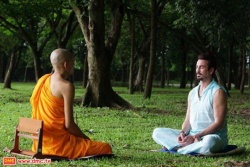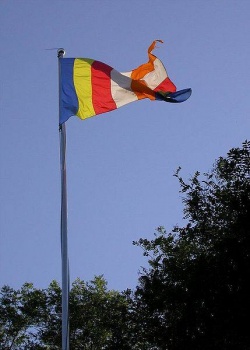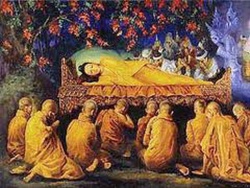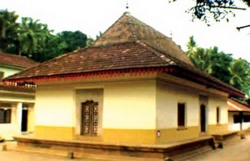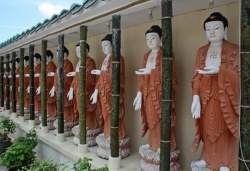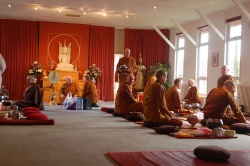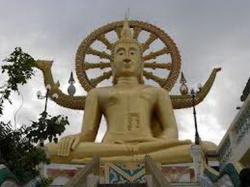Significance Of The Ritual Concerning Offerings To Ancestors In Theravada Buddhism
Significance Of The Ritual Concerning Offerings To Ancestors In Theravada Buddhism
P.D. Premasiri
A major aspect of the Buddha's teaching was its critique of contemporary religious practices. The Buddha's critique was mainly directed against the over-ritualization of religion leading to the loss of all spiritual and ethical meaning and the degeneration of religion into a mere series of mechanical observances of ritual. The Buddhist attitude towards ritual can be seen from its reference to silibbata-paramasa(clinging to rules and rites), an expression used to signifY an attitude of over-dependence on ritual which, from the Buddhist perspective, was considered a hindrance to genuine spiritual upliftment of the individual.
Silibbata are reckoned in Buddhism among the foremost fetters to be destroyed by the person who enters into the path of spiritual progress. In the Buddhist critique of ritual an effort was made to show that some rituals involved immorality as in the case of the sacrificial rituals of the Brahmans leading to the killing of animals, while others involved the mere performance of futile acts diverting people from genuine spiritual upliftment, as in the case of bathing in sacred rivers to wash off one's sins. The Buddhist emphasis was on genuine and effective transformation of the inner spiritual nature of man. Ritual can, from the Buddhist point of view, be justified only to the extent that it contributes to spiritual transformation.
Buddhism appears to have recognized the fact that, especially in the case of the ordinary lay people, ritual can be an effective instrument in guiding their spiritual destinies. For there is a natural tendency in man to ritualize his behavior in the face of the more important and striking activities and events of his life such as birth, death, marriage, etc. Whenever possible Buddhism attached a new meaning and significance to contemporary rituals and admitted them to the Buddhist fold, giving them a novel ethical character. The purpose of this paper is to make some observation on the way in which Buddhism attached a new significance to the pre-Buddhistic ritual concerning ancestor worship and transformed an existing ritual to fit in with the moral and pragmatic outlook of Buddhism. Ancestor worship is regarded as one of the great branches of the religions of mankind. It is believed that the principles of this practice help to keep up the social relations of the living world. The dead ancestor is usually believed to survive in the form of a deity. He is believed to be in continuing relationship with the living, protecting his own family and himself receiving benefits from the family. There are three major reasons for the wide prevalence of ancestor worship among numerous cultures from very ancient times. First, attachment to the dead and the psychological necessity to feel the continuing presence of loved ones who have departed from this world. Second, expectation of benefits from the dead ancestors, especially in the struggle of primitive man for survival. Third, fear of the dead is also a widespread reason for ancestor worship. In many cultures appeals are often made to the departed spirits, imploring them not to return and vex their friends.
In India a vast literature has grown around the ritual of ancestor worship, indicating the importance attached to this ritual in Indian society. It is admitted that even today it is the most important ceremony of the Hindus. The belief in the eXistenceof departed ancestors and the presentation of offerings to them have always formed a part of the Hindu domestic religion. In the Vedic period it was believed that the spirit of the dead became a pitr immediately after the disposal of his corpse. According to the original Vedic religion, the dead ancestors survive in the blissful world of the "fathers" (pitrloka) and, like gods, partake of the sacrificial offeEngs by the people. In the Vedic funeral hymn, the dead man is urged to "go forth by those ancient paths on which the fathers of old have passed away."
The pitrs were considered in the Vedas as the blessed dead who dwell in the third heaven or highest step ofVi~I)u. They are in companionship with Yama, the Lord of the Dead, and take their food with the gods. They enjoy soma and desire libations prepared for them at the sacrificial offerings of the living. The pitrs look after their worshippers and are invoked by the living to give riches, children and long life. The following formula is found in the Atharvaveda as one to be recited for the invocation of the pitrs: "Come ye 0 fathers, delectable, by profound roads that the fathers travel; assigning to us life, time and progeny and do ye attach yourself to us with abundance of wealth."1
In the Vedic period the ritual of apcestor worship consisted in the casting of sacrificial materials into the tIre, a practice which was known as agnaukara1}a.This was probably the pitrjajfia sacrifice known to the Rgvedic people. Animal sacrifices such as burning of a goat and a cow along with the dead formed an important part of the sacrificial ritual. Although the Vedic conception of the pitrloka was one of a world of heavenly and blissful existence, in the Brahmanic period the conception of a woeful world, known as the pretaloka into which the dead ancestors pass, emerged. In the Grhya period the idea was introduced that a man immediately after his death became a preta and subsequently became a pitr, provided that some rites were performed for his release from the preta stage. The time span taken for apreta to become apitr was believed to be a year. According to the Purti1}as,as soon as the gross corporeal body of a dead person is burnt the soul of the person takes a subtle body called the ativtihika!arira. In this state the person is said to suffer from extreme heat and cold, hunger and thirst. The soul could be released from this stage by performing the rite of the offering of puraka lumps. When the soul is released from the subtle body, it acquires the preta!arlra. Still one does not acquire the full-fledged status of a pitr entitling one to partake of all subsequent rites of ancestor worship. In the pre-Buddhist Vedic ritual concerning ancestor worship, the emphasis was on the direct transference of material things to the ancestors through offerings made by the living. The term fritddha was used in the Vedic tradition to refer to the rite of ancestor worship. This rite was also known as the pitrmedha sacrifice. In section XXXV of the Vajasaneyi Sa1'J'lhitaof the Yajurveda, which contains some funeral verses, is found a description of a ceremony known aspitrmedha. In this ceremony the burnt bones of the dead were placed in an urn and deposited in the earth. Cakes and grains mixed with sesame were placed on bones. Vessels containing articles of food were buried under stones or bricks with the remains of the dead body. Although in the early stages of the Vedic ritual, the practice was the direct offering of food and other sacrificial items to the dead; later the feeding of Brahmanas was introduced as the essential element.
In Buddhism the term peta generally meant "departed one." This term also acquired a special meaning when it began to be used to refer to a special class of beings who dwell in the world of petas (petaloka). The Buddhists, in accordance with the doctrine of kamma and rebirth, conceived of a world of ghostly existence called the pettivisaya. Petti- in pettivisaya has a verbal correspondence to the Vedic pitr; but unlike the Vedic pitrs the beings inhabiting the pettivisaya lead a pitiable and painful existence as a consequence of their bad kamma in a previous life. The petas belong to the class of vinipiitikas"those who lead a woeful life in hell. In theAfiinii#ya-sutta the petas are described as beings bent on evil, as backbiters, murderous brigands, crafty-minded rogues, thieves, and cheats.
The Buddhist peta belief found its formal expression in the Petavatthu, a text in verse included in the Khuddaka-nikaya, the fifth collection of the Sutta P#aka. Reference to the conception of petas is found scattered in other sections of the Buddhist canon, as well, suggesting that the earlier Brahmanical ritual found its way into Buddhism at a very early period. The correspondence with the Brahmanical belief comes to light in the Grhya list of mahayajfia and a similar list of five bali mentioned in the Buddhist texts. The pitryajfia mentioned in the Grhya list corresponds to the pubbapetabalimentioned in the Buddhist lisp An offering of gifts in honor and for the sake of the dead ancestors was considered as a sacred duty of the Buddhist householder (petana1'J'l dakkhi1;a1'J'l anuppadassati). Parents are said to desire sons in the family, expecting that they would perform the duty of making these offerings once the parents pass away.3The Tirokutf,t;ia-sutta, occurring in both the Petavattthu and the Kuddhakapafha included in the Khuddaka-nikiiya, represents the traditional Buddhist position regarding the petadakkhi1;ii (offering to ancestors) .
According to this sutta, petas visit their own homes and stay across the walls at cross roads and junctions, unable to receive anything from their kinsmen even when they hold great feasts. Compassionate and grateful kinsmen do not fail to make offerings to the petas. When such offerings are made the petas, who have no other means available in their woeful state of existence to obtain their requirements than through the offerings made by their living kinsmen, become happy and wish their kinsmen long life and happiness. The'living, through gratitude for what their ancestors have done for them, should not fail to make offerings to the latter. The best way in which the interests of one's beloved ones who have departed to the other world can be served is by making such offerings to them, and not by crying, sorrowing, or lamenting over the loss of the loved ones. The effective mode of offering recognized in the sutta is not direct offering of material things to the petas but making offerings to the virtuous community of bhikkhus, dedicating the gifts expressly to the ancestral petas, as a consequence of which the latter are said to be released from their sufferings and pass into a better form of rebirth. The canonical conception of petas and the ritual connected with offerings to them in Buddhism has several distinctive features when compared with the pre-Buddhistic ritual concerning ancestor worship.
First, the Buddhist belief is that the living are not dependent on the petas for their well being in this world, iQ that the petas are conceived as inferior beings who are in need of the assistance of the living. Second, Buddhism emphasizes, through the practice of offerings to the petas, the virtue of gratitude. The Tirokut;itf.a-suttagives expression to this idea thus: "He gave to me, he worked for me, he was my kin, friend, intimate. One ought to give gifts for departed ones, through gratitude for what they have done in the past." Third, the ritualistic aspect of the offerings in Buddhism is comparatively very simple, and Buddhism has got rid of the elaborate forms of Brahmanic ritual connected with the practice. Animal sacrifices are never recommended, and there is a deliberate attempt to moralize the practice. The best and the most efficacious manner in which thepetas can be helped is said to be by making offerings to spiritually elevated persons. According to the TirokucJ4a-sutta, "When the offering is given to the well-placed in the community, it can be of benefit to them (the petas) for long." By offering alms to the Sangha, the laymen come into contact with the spiritual community; they also get an opportunity to eliminate their greed and attachment to wealth and other material things by practicing generosity. Consequently their merit is said to increase. Finally, the Buddhists look upon the petadakkhi1:u:i as a practice conducive to lessening the grief of the living on account of the death of their loved ones by suggesting that there is yet an effective means of caring for loved ones who are dead, giving a considerable degree of consolation for the living. The Tirokut; itf.a-sutta emphasizes this point thus: "Neither weeping nor sorrowing nor any kind of lamentation aides the departed ones."
The Pali canonical texts or commentaries do not reveal any details regarding the ritualistic procedure to be followed in making offerings to ancestors. However, the traditionally preserved popular ritualistic practice followed by Theravada Buddhists of Sri Lanka can be observed at the performance of funeral rites and alms givings. It is customary for Theravada Buddhists of Sri Lanka to offer alms (dana) to the Sangha in their homes, at certain fixed intervals of time after the death of a relative. An alms giving for the sake of the dead relative is invariably held on the seventh day after the death. This is usually followed by one, three months, and another, one year after the death. The current belief is that the living relatives of the dead person make merit by giving dana to virtuous monks. Not less than five bhikkhus are invited by the relatives to their home and gifts of food and other requisites of bhikkhusare given at these dana ceremonies. On these occasions many friends and relatives of the dead person gather to participate in the meritorious act of making offerings to the Sangha.
The alms food is formallyoffered to the Sangha by repeating the usual Pali sentence three times: Ima1!'l.bhikkha1!'l bhikkhusanghassadema (We offer this food to the community ofbhikkhus"). When the monks finish partaking of the meal they are offered other requisites (pirikara). Finally a small bowl or dish and a pitcher of water are brought before the bhikkhus by the immediate relatives of the dead person. At this moment everyone assumes a reverent posture, and the head of the household slowly pours the water into the dish till it overflows. While this is being done the monks recite together the following verses:
- Unname udakal'J'l.vUJ:!
- hal'J'l. yatha ninnal'J'l.pavattati
- evameva ita din'fJal'J'l. petanal'J'l.upakappati.
- Yatha varivaha para paripurenti sagaral'J'l.
- evameva ita dinnal'J'l.petanal'J'l.upakappati.
- ("As water showered on high ground flows down to the plain,
- similarly what was given here serves the departed ones.
- As streams full of water flow to fill the ocean,
- similarly what was given here serves the departed ones.")
This water pouring ritual takes place at the funeral itself. Before the body of a dead person is cremated or buried the Buddhist monks perform a simple funeral rite. A white cloth is laid on the coffin, and the funeral gathering repeats three times after the chief monk present the following formula: Ima1!'lmatakavattha1!'lbhikkhusanghassadema (We give this clothing dedicated to the dead to the community of monks"). A close relative then performs the ritual of pouring water as at the dana, while the monks recite the same verses recited on that occasion.
The most interesting question that arises with regard to the Buddhist practice of making offerings for the benefit of the dead concerns the Buddhist doctrinal explanati~n of this ritual. Canonical and commentarial references to the ritual indicate that the ancestors benefit by the offerings made by the living relatives only if they are specifically dedicated to them by the former. According to the Tirokutj,tJa-sutta,where we find the classical expression of the Buddhist belief and practice, the petas subsist on what is given by their relatives in this world (ito dinnena yapenti peta kalakata tahi1fl). The commentary to the sutta of the Tiroku44a Petavatthu mentions the story of King Bimbisara who gave alms to the Buddha but did not dedicate it to the petas. As a result the petas, who were expecting the king to dedicate the offering to them, appeared at the king's palace in the night and made a terrifying noise. The king who met the Buddha was advised by him to give alms again and dedicate them to the petas. The petas are said to have benefitted instantly by the offerings. Pleasant ponds covered with lotuses and lilies, sumptuous food fit for consumption by divine beings and divine clothes and dwelling places are said to have appeared before the petas for their benefit.4 .
The current Theravada Buddhist practice in Sri Lanka of transferring merit to the relatives appears to be directly connected with this conception that the condition of the dead relatives can be improved if the merit acquired by performing a good deed is dedicated to them. Mter the performance of any meritorious act, it is customary for the Buddhists to transfer the merit acquired to the ancestors uttering the following verse: lda1flmenatlna1flhotu sukhita hontu natayo.("May this be for my relatives and may the relatives be happy.")
The current view, and the one which may be said to be the official Theravadin viewregarding ofierings to ancestors, is that the ancestors who are born in the peta world alone can benefit from offerings dedicated to them. The belief that was prevalent among the Vedic people and in many other primitivecultures that ancestors can direcdy benefit from the material things offered to them is not accepted in Theravada Buddhism. The canonicalposition regarding offerings to ancestors is not altogether clear assuttas like the Tirokut#a-sutta only mention that thepetassubsist on what is given from this world, but the mechanics of such subsistence is not described at all. The Kathavatthu as well as the commentary to the Kathavatthu expressly reject the view that the petas subsist on material things given from this world (na h)ete ita dinnena 1Jatthuna-yapenti).
According to the Theravadin view expressed in the commentary to the Kathavatthu, the belief that the petas benefit by the very same material items offered by the people of this world is a Buddhist heresy held by some sects like the Rajagirikas and the Siddhatthikas. The Kathavatthu shows that the Theravadin was in agreement with the view that the petas approve with joy, rejoice, and are pleased in mind and become happy when someone performs the meritorious deed of giving dana for their sake (Nanu peta attano atthaya dana1ftdenta1ftanumodenti citta1ftpasadenti) piti1ft uppadenti) somanassa1ftpapilabhantiti? Amantati.)5 According to this view the petas benefit not by the merit acquired by someone being transferred to them, in which case it would contradict the Buddhist doctrine of kamma, but by the rejoicing of the petas in the good deeds of others. This idea does not contradict the Buddhist doctrine of kamma. For the Buddhist doctrine explains kamma primarily as the functioning of a psychological law. The moral and rational outlook of Buddhism did not permit it to adopt a primitive practice in its original form. Therefore, it changed its character by reinterpreting the significance of the ritual.
Thus the Buddhist ritual concerning ancestor worship is yet another example of the adaptation of existing ritual to suit the spiritual and moral needs of the Buddhist. As B..C. Law remarks, "The guiding principle of practical Buddhism not to introduce anything which is inconsistent with the existing tradition of the time and not to upset anything which is well established as a custom, the belief itself and the social functions and religious rites based upon it, were recognized as a matter of course."6 Buddhism gave a moral outlook to the whole ritual focussing attention on the evil consequences of immoral action and the wholesome consequences of good action. As in the case of many other contemporary ritualistic practices, Buddhism changed the character of the ritual by both moralizing and psychologizing it.
NOTES
1. Dakshina Ranjan Shastri, Origin and Development ofthe Rituals of Ancestor Worship in India, 22.
2. A, 3.45.
3. Ibid., 3.6.
4. DhA, 1.103-104.
5. KPu2.347.
6. B.c. Law,The Buddhist Conception of Spirits, London: Luzac, 1936, 8.
Source
Significance of the Ritual Concerning Offerings to Ancestors in Theravāda Buddhism, P.D. Premasiri, Buddhist Throught and Ritual, ed. by David J. Kalupahana, New York, 1991, pp.151-158. profpremasiri.com
